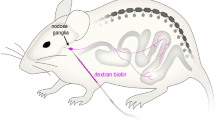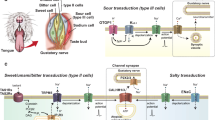Summary
The infundibular nucleus of various reptiles was studied light and electron microscopically. Cells of this nucleus send processes through a stratified ependyma into the 3rd ventricle where they form free, intraventricular nerve terminals (“liquor contacting nerve endings”, LCNE). In the nucleus, two kinds of neurons could be distinguished light microscopically: a) small, AChE-negative, toluidine blue neurons, and b) large, AChE-positive cells staining light with toluidine blue.
The club shaped LCNE contain elements of the endoplasmic reticulum, free ribosomes, a various amount of mitochondria, and single lysosomes. The terminals bear asymmetrical cilia (type 9+0) supplied with accessory basal bodies and rootlet fibres. Two kinds of LCNE are demonstrable: a) LCNE containing dense-core vesicles with a diameter of about 800–1100 Å, and b) LCNE with large, electron-dense granules (diameter about 1,200–1,600 Å). In the lumen of the 3rd ventricle, there occur small axons that contain small granulated vesicles (diameter about 700–900 Å), and that form intraventricular synapses with the LCNE of the infundibular nucleus.
The perikarya of the infundibular nucleus contain an abundant endoplasmic reticulum, numerous polyribosomes, neurotubules and mitochondria. Similarly to the LCNE, two kinds of perikarya can be distinguished: a) perikarya containing granulated vesicles (diameter about 800–1100 Å), and b) perikarya with electron-dense granules (diameter about 1200–1700 Å). Furthermore, different types of axosomatic and axodendritic synapses occur.
The function of the intraventricular nerve terminals and the different types of synapses in the nucleus is discussed with regard to an exchange of informations between the cerebrospinal fluid and the infundibular nucleus.
Zusammenfassung
Der Nucleus infundibularis verschiedener Reptilien wurde licht- und elektronenmikroskopisch untersucht. Zellen dieses Kernes entsenden Fortsätze durch ein mehrreihiges Ependym in den 3. Ventrikel und bilden dort freie, intraventrikuläre Nervenendigungen („Liquorkontakt-Nervenendigungen“, Lkne). Lichtmikroskopisch konnten in der Kerngruppe a) kleine, AChE-negative, toluidinblaue und b) große, AChE-positive, mit Toluidinblau hell erscheinende Nervenzellen unterschieden werden.
Die knöpfchenförmigen LKNE weisen Elemente des endoplasmatischen Retikulums, freie Ribosomen, eine wechselnde Anzahl Mitochondrien, einzelne Lysosomen, asymmetrische Zilien (Typ 9+0) mit akzessorischem Basalkörper und Zilienwurzeln auf. Zwei LKNE-Typen sind unterscheidbar: a) LKNE mit granulierten Vesikeln mit einem Durchmesser von 800–1100 Å und b) LKNE mit großen, elektronendichten Granula (Durchmesser 1200–1600 Å).
Im Lumen des 3. Ventrikels treten kleinkalibrige Axone auf, die kleine, granulierte Bläschen (Durchmesser 700–900 Å) enthalten und mit den LKNE des Nucleus infundibularis intraventrikuläre Synapsen bilden.
Die Perikaryen des Nucleus infundibularis weisen ein reichliches endoplasmatisches Retikulum, zahlreiche Polyribosomen, Neurotubuli und Mitochondrien auf. Ähnlich wie bei den LKNE sind zwei Perikaryenarten zu unterscheiden: a) Perikaryen mit granulierten Vesikeln (Durchmesser 800–1100 Å) und b) solche mit elektronendichten Granula (1200–1700 Å). Außerdem kommen verschiedene Arten axosomatischer und axodendritischer Synapsen vor.
Die Funktion der intraventrikulären Nervenendigungen und verschiedenen Synapsenarten in der Kerngruppe wird im Hinblick auf einen Informationsaustausch zwischen dem Liquor cerebrospinalis und dem Nucleus infundibularis diskutiert.
Similar content being viewed by others
Literatur
Agduhr, E.: Über ein zentrales Sinnesorgan (?) bei den Vertebraten. Z. Anat. Entwickl.-Gesch. 66, 223–360 (1922).
Bargmann, W.: Über die neurosekretorische Verknüpfung von Hypothalamus und Neurohypophyse. Z. Zellforsch. 34, 610–634 (1949).
—: Über Synapsen im endokrinen System. Nova Acta Leopoldina, N. F. 30, 199–206 (1965).
—: Conclusions-Schlußwort-Résumé. In: Neurosecretion, ed. F. Stutinsky, p. 241–247. Berlin-Heidelberg-New York: Springer 1967.
—, Gaudecker, Br. v.: Über die Ultrastruktur neurosekretorischer Elementargranula. Z. Zellforsch. 96, 495–504 (1969).
—, Knoop, A., Thiel, A.: Elektronenmikroskopische Studie an der Neurohypophyse von Tropidonotus natrix (mit Berücksichtigung der Pars intermedia). Z. Zellforsch. 47, 114–126 (1957).
—, Lindner, E., Andres, K. H.: Über Synapsen an endokrinen Epithelzellen und die Definition sekretorischer Neurone. Untersuchungen am Zwischenlappen der Katzenhypophyse. Z. Zellforsch. 77, 282–298 (1967).
Bock, R.: Über die Darstellbarkeit neurosekretorischer Substanz mit Chromalaun-Gallocyanin im supraoptico-hypophysären System beim Hund. Histochemie 6, 362–369 (1966).
Dahlström, A., Fuxe, K.: Evidence for the existence of monoamine-containing neurons in the central nervous system. Acta physiol. scand. 62, Suppl.232, 1–55 (1965).
Etcheverry, J. G., Pellegrino de Iraldi, A.: Ultrastructure of the neurons of the arcuate nucleus of the rat. Anat. Rec. 160, 239–254 (1968).
Gabe, M.: Sur quelques applications de la coloration par la fuchsine-paraldéhyde. Bull. Micr. appl. 3, Ser. II, 153–162 (1953).
Harris, G. W., Reed, M., Fawcett, C. P.: Hypothalamic releasing factors and the control of anterior pituitary function. Brit. med. Bull. 22, 266–272 (1966).
Karnovsky, M. J., Roots, L.: A direct “coloring” thiocholin method for cholinesterases. J. Histochem. Cytochem. 12, 219–221 (1964).
Knowles, F.: Neuronal properties of neurosecretory cells. In: Neurosecretion, ed. F. Stutinsky, p. 8–19. Berlin-Heidelberg-New York: Springer 1967.
Kolmer, W.: Über einen supraependymalen Nervenplexus in den Hirnventrikeln der Affen. Z. Anat. Entwickl.-Gesch. 93, 182–187 (1930).
Leonhardt, H.: Zur Frage einer intraventrikulären Neurosekretion. Eine bisher unbekannte nervöse Struktur im IV. Ventrikel des Kaninchens. Z. Zellforsch. 79, 172–184 (1967).
Leonhardt, H.: Neurosekretorische Strukturen im IV. Ventrikel und Zentralkanal beim Kaninchen. Verh. Anat. Ges. Ergh. Anat. Anz. 121, 95–102 (1968a).
—: Ependym und Ependymsekretion. In: Zirkumventrikuläre Organe und Liquor. Bericht über das Symposium in Schloß Reinhardsbrunn 1968 b, ed. G. Sterba, p. 177–190. Jena: VEB Fischer 1969.
—: Bukettförmige Strukturen im Ependym der Regio hypothalamica des III. Ventrikels beim Kaninchen. Zur Neurosekretions- und Rezeptorenfrage. Z. Zellforsch. 88, 297–317 (1968).
- Zur Frage der ventrikulären Neurosekretion. Int. Symp. on Neurosecretion, Kiel 1969. In: Aspects of neuroendocrinology, herausgeg. von Bargmann, W., Scharrer, B. Berlin-Heidelberg-New York: Springer (im Druck).
—, Backhus-Roth, A.: Synapsenartige Kontakte zwischen intraventrikulären Axonendigungen und freien Oberflächen von Ependymzellen des Kaninchengehirns. Z. Zellforsch. 97, 369–376 (1969).
—, Prien, H.: Eine weitere Art intraventrikulärer kolbenförmiger Axonendigungen aus dem IV. Ventrikel des Kaninchengehirns. Z. Zellforsch. 92, 394–399 (1968).
Mazzuca, M.: Étude préliminaire au microscope électronique du noyau infundibulaire chez le cobaye. In: Neurosecretion, ed. F. Stutinsky, p. 36–41. Berlin-Heidelberg-New York: Springer 1967.
Mess, B., Fraschini, F., Motta, M., Martini, L.: The topography of the neurons synthesizing the hypothalamic releasing factors. Excerpta Medica Int. Congr. Ser. 132, p. 1004–1013. Proc. 2nd Intern. Congr. Hormonal Steroids, Milan 1966.
Müller, H., Weiss, J., Sterba, G.: Hydrencephalocrinie bei der Bachforelle. In: Zirkumventrikuläre Organe und Liquor, ed. G. Sterba, p. 273–276. Jena: VEB Fischer 1969.
Odake, G.: Fluorescence microscopy of the catecholamine-containing neurons of the hypothalamo-hypophyseal system. Z. Zellforsch. 82, 46–64 (1967).
Oehmke, H. J.: Topographische Verteilung der Monoaminfluoreszenz im Zwischenhirn-Hypophysensystem von Carduelis chloris und Anas platyrhynchos. Z. Zellforsch. 101, 266–284 (1969).
—, Priedkalns, J., Vaupel-v. Harnack, M., Oksche, A.: Fluoreszenz- und elektronenmikrosko pische Untersuchungen am Zwischenhirn-Hypophysensystem von Passer domesticus. Z. Zellforsch. 95, 109–133 (1969).
Oksche, A.: Eine licht- und elektronenmikroskopische Analyse des neuroendokrinen Zwischenhirn-Vorderlappen-Komplexes der Vögel. In: Neurosecretion, ed. F. Stutinsky, p.77–88. Berlin-Heidelberg-New York: Springer 1967.
Priedkalns, J., Oksche, A.: Ultrastructure of synaptic terminals in Nucleus infundibularis and Nucleus supraopticus of Passer domesticus. Z. Zellforsch. 98, 135–147 (1969).
Rodriguez, E. M.: Morphological and functional relationships between the hypothalamo-hypophysial systems and cerebrospinal fluid. Int. Symp. on Neurosecretion, Kiel 1969. In: Aspects of neuroendocrinology, herausgeg. von W. Bargmann u. B. Scharrer. Berlin-Heidelberg-New York: Springer (im Druck).
Scharrer, B.: Neurohumors and neurohormones: definition and terminology. J. neuro-visceral Relations 9, Suppl., 1–20 (1969).
Scharrer, E., Scharrer, B.: Neurosekretion. In: Handbuch der mikroskopischen Anatomie des Menschen, ed. W. Bargmann, Bd. VI/5, p. 953–1066, Berlin-Göttingen-Heidelberg: Springer 1954.
Sharp, P. J., Follett, B. K.: The distribution of monoamines in the hypothalamus of the Japanese quail, Coturnix japonica. Z. Zellforsch. 90, 245–262 (1968).
Smoller, C. G.: Neurosecretory processes extending into third ventricle: secretory or sensory? Science 147, 882–884 (1964).
Szentágothai, J.: The synaptic architecture of the hypothalamo-hypophyseal neuron system. Acta neurol. belg. 69, 453–486 (1969).
—, Flerkó, B., Mess, B., Halász, B.: Hypothalamic control of the anterior pituitary. An experimental-morphological study. Budapest: Akadémiai Kiadó 1968.
Teichmann, I., Vigh, B.: Histochemical investigation of the monoamine-containing neurons of the paraventricular organ and the preoptic recess of amphibians (Rana esculenta, Ambystoma mexicanum). Acta biol. Acad. Sci. hung. 19, 505 (1968).
Teichmann, I., Vigh, B., Aros, B.: Histochemical studies on Gomori-positive substances. IV. The Gomori-positive material of the paraventricular organ in various vertebrates. Acta biol. Acad. Sci. hung. 19, 163–180 (1968).
Vigh, B.: Morphological and morphophysiological examination of the paraventricular organ. (In Hungarian). Thesis, Budapest 1968a.
—: The Paraventricular organ, its structure and function. In: Zirkumventrikuläre Organe und Liquor. Bericht über das Symposium in Schloß Reinhardsbrunn 1968, ed. G. Sterba, p. 147–150. Jena: VEB Fischer 1969.
- Das Paraventrikularorgan und das zirkumventrikuläre System. Budapest: Akadémiai Kiadó (im Druck).
—, Teichmann, I., Aros, B.: Das Paraventrikularorgan und das Liquorkontakt-Neuronen system. 63. Verh. Anat. Ges. Leipzig 1968. Ergh. Anat. Anz. 125, 683–688 (1969).
Vigh-Teichmann, I.: Hydrencephalocriny of neurosecretory material in amphibia. In: Zirkumventrikuläre Organe und Liquor. Bericht über das Symposium in Schloß Reinhardsbrunn 1968, ed. G. Sterba, p. 269–272. Jena: VEB Fischer 1969.
—, Röhlich, P., Vigh, B.: Licht- und elektronenmikroskopische Untersuchungen am Recessus praeopticus-Organ von Amphibien. Z. Zellforsch. 98, 217–232 (1969).
—, Vigh, B.: The neurosecretory preoptic nucleus as a member of the liquor contacting neuronal system. Acta morph. Acad. Sci. hung. 17, 338 (1969a).
—: Liquor contacting neuronal areas in the periventricular gray substance of the central nervous system. Gen. comp. Endocr. 13, 537 (1969b).
- - Structure and function of the liquor contacting neurosecretory system. Int. Symp. on Neurosecretion, Kiel 1969c. In: Aspects of neuroendocrinology, herausgeg. von W. Bargmann u. B. Scharrer. Berlin-Heidelberg-New York: Springer (im Druck).
—, Aros, B.: Phylogeny and ontogeny of the paraventricular organ. In: Zirkumventriku läre Organe und Liquor. Bericht über das Symposium in Schloß Reinhardsbrunn 1968, ed. G. Sterba, p. 151–154. Jena: VEB Fischer 1969.
—: Fluorescence histochemical studies on the preoptic recess organ in various vertebrates. Acta biol. Acad. Sci. hung. 20, 425–438 (1969).
—: Enzymhistochemische Studien am Nervensystem. IV. Acetylcholinesteraseaktivität im Liquorkontakt-Neuronensystem verschiedener Vertebraten. Histochemie 21, 322–337 (1970).
—, Koritsánszky, S.: Liquorkontaktneurone im Nucleus paraventricularis. Z. Zellforsch. 103, 483–501 (1970a).
—: Liquorkontaktneurone im Nucleus lateralis tuberis von Fischen. Z. Zellforsch. 105, 325–338 (1970b).
Weatherhead, B.: Intra-ventricular ependymal processes in the pars nervosa of a chelonian, Emys orbicularis. Gen. comp. Endocr. 13, 539–540 (1969).
Wittkowski, W.: Elektronenmikroskopische Studien zur intraventrikulären Neurosekretion in den Recessus infundibularis der Maus. Z. Zellforsch. 92, 207–216 (1968).
—: Ependymokrinie und Rezeptoren in der Wand des Recessus infundibularis der Maus und ihre Beziehung zum kleinzelligen Hypothalamus. Z. Zellforsch. 93, 530–546 (1969).
Author information
Authors and Affiliations
Rights and permissions
About this article
Cite this article
Vigh-Teichmann, I., Vigh, B., Koritsánszky, S. et al. Liquorkontaktneurone im Nucleus infundibularis. Z. Zellforsch. 108, 17–34 (1970). https://doi.org/10.1007/BF00335940
Received:
Issue Date:
DOI: https://doi.org/10.1007/BF00335940




